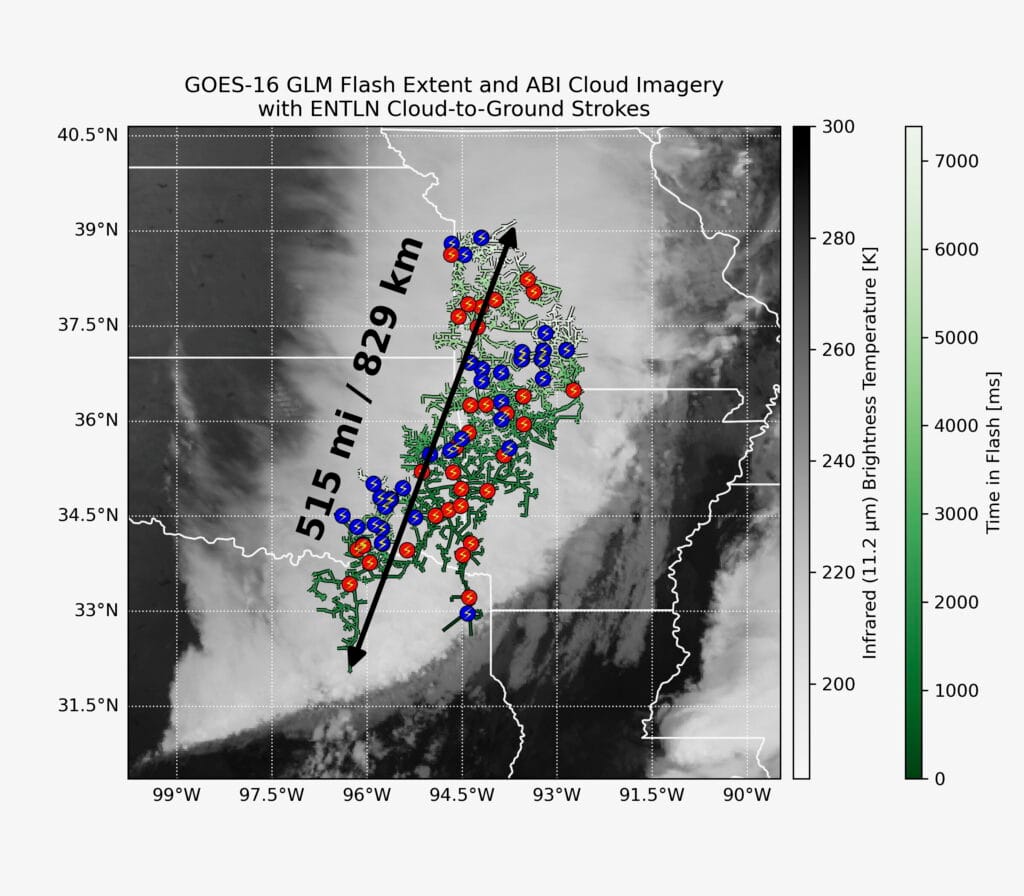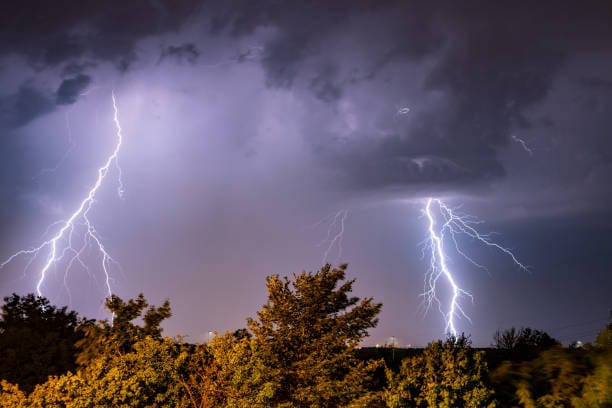One October night in 2017, high above the rolling grasslands of the Great Plains, nature wrote its name in fire across the sky. A single lightning bolt—known as a megaflash—streaked for an astonishing 515 miles, from eastern Texas nearly all the way to Kansas City. That bolt, unseen by most on the ground and silent to all until years later, has now been crowned the longest lightning flash ever recorded.
“It’s staggering,” said Randy Cerveny, an Arizona State University professor and climate expert for the World Meteorological Organization (WMO). “We call it megaflash lightning and we’re just now figuring out the mechanics of how and why it occurs.”
While most lightning bolts are fierce but fleeting—flashing just a few miles in reach before fading into the sky—this record-breaking strike outpaced even the largest expectations of meteorologists. The 515-mile bolt surpassed the previous record, set in 2020 at 477 miles, by an impressive 38 miles.
A Record Hidden in the Stars
This was not a bolt that lit up the headlines in 2017. In fact, it went entirely unnoticed—until researchers turned their eyes skyward. The discovery was made not through ground-based instruments, but by satellite.
Orbiting 22,000 miles above Earth, NOAA’s GOES-16 weather satellite was quietly gathering data during the storm. That data was re-examined years later with the help of new lightning detection technology—and the evidence was clear. The massive bolt had indeed happened. It had simply been too vast, too fast, and too unusual for traditional ground-based sensors to capture in full.
“Our weather satellites carry very exacting lightning detection equipment that we can use to document to the millisecond when a lightning flash starts and how far it travels,” Cerveny said. “It’s only with this satellite perspective that we could see the whole thing unfold.”

The flash is now officially recognized by the World Meteorological Organization as the longest single lightning bolt ever documented. But researchers suspect it may not hold the record for long.
A New Eye on the Sky
The technological leap that made this discovery possible is the geostationary lightning mapper—an instrument designed to detect flashes continuously over vast geographic areas. Installed aboard the GOES-16 satellite and its successors, this sensor tracks every flicker of lightning activity from a stationary perch above the Western Hemisphere.
“The addition of continuous measurements from geostationary orbit was a major advance,” explained Michael Peterson, lightning researcher at the Georgia Tech Research Institute and lead author of the study published in the Bulletin of the American Meteorological Society. “We’re now at a point where most of the global megaflash hotspots are covered by satellite, and data processing techniques have improved to properly represent flashes in the vast quantity of observational data.”
GOES-16 and its companions, launched by NOAA, the European Space Agency, and China, detect more than one million lightning flashes per day. These are not just visual observations. The satellites measure the light produced by each strike in fine detail, tracking both the start point and travel path across land and sky.
In contrast, ground-based systems detect lightning by catching radio waves emitted during a strike and triangulating the flash’s origin. While effective for counting and locating more typical bolts, those systems can lose sight of the forest for the trees when a lightning strike stretches hundreds of miles across multiple states.
What Exactly Is a Megaflash?
To most of us, lightning is lightning: a bright, crackling jolt from cloud to ground. But the lightning that broke the world record in 2017 defies ordinary description.
A megaflash is defined as a lightning flash that stretches horizontally over more than 60 miles (or 100 kilometers). They are rare—less than 1% of all lightning—and they’re not the result of a single jagged bolt arcing from sky to earth. Instead, megaflashes race through the upper regions of thunderstorm clouds, traveling from one thunderhead to the next like a flickering pulse across a continent.
They often begin high in the atmosphere, skipping across the tops of storm systems that are massive in scale and long-lived in time, sometimes churning for 14 hours or more and covering areas the size of New Jersey.
The average megaflash is composed of multiple branching fingers—five to seven on average—that split from the main bolt to strike the ground as it races across the sky. But the vast majority of the flash remains horizontal, weaving through the complex electrical structure of the storm.
It’s a phenomenon that has puzzled scientists for decades, in part because its sheer scale makes it so difficult to observe in real time.
Why Megaflashes Matter
For meteorologists, megaflashes are not just curiosities. They’re clues.
Lightning is a key indicator of storm intensity, and megaflashes may signal particular patterns of electrical activity that correlate with the most dangerous thunderstorms—those capable of producing tornadoes, hail, or devastating downbursts.
Understanding how megaflashes form and propagate could help scientists better model these superstorms, giving more accurate warning systems to communities in their path.
“We’re beginning to get a much better sense of how lightning connects across vast regions of the atmosphere,” Peterson said. “That knowledge could help us understand energy transfer within storms and improve our ability to predict the onset of extreme weather.”
But there’s another reason why megaflashes—and lightning in general—should command our attention: they’re deadly.
The Hidden Reach of Danger
On average, lightning kills 20 to 30 people in the United States each year and injures hundreds more. While deaths have decreased in recent decades due to public awareness campaigns, a hidden risk remains: lightning’s reach is far greater than most people realize.
“People think that if the storm isn’t overhead, the danger is past,” Cerveny explained. “But lightning can strike 10, 15, even 20 miles away from the heart of a storm. And those are often the strikes that catch people off guard.”
In fact, many lightning-related injuries occur before or after the main storm event—when skies may appear calm and thunder has faded into the distance.
That’s why experts advise waiting at least 30 minutes after the last clap of thunder before resuming outdoor activities. The storm that produces a lightning strike doesn’t need to be above you; it just needs to be nearby.
In the case of megaflashes, the horizontal reach is so vast that one flash can span multiple counties or even states. That means someone standing under blue skies could be at risk from a lightning strike originating from a storm far off on the horizon.
Beyond the Horizon
The 515-mile megaflash has now been etched into the record books, but its story is far from over. For researchers, it’s a symbol of how much we’ve yet to learn about the electric rhythms of the atmosphere.
Megaflashes remind us that weather is not just a local experience but a vast, dynamic system in which energy is transferred across immense distances—sometimes in the blink of an eye. They hint at an interconnectedness in the atmosphere that mirrors patterns seen in climate, ecology, and even the planet’s magnetic field.
New satellite tools are offering humanity its first full glimpse into these patterns. With instruments that can observe storms in real time, across thousands of miles, researchers are poised to rewrite the textbooks on what lightning can do.
“We’re likely only scratching the surface,” Cerveny said. “Greater extremes almost certainly exist. And as we accumulate more high-quality lightning data from satellites, we’ll find them.”
Lightning, Reimagined
In many cultures, lightning is the language of the gods—a symbol of fury and power. In modern science, it is a subject of intense study and ever-deepening mystery.
The 515-mile megaflash is not just a meteorological oddity. It’s a challenge to our assumptions. It tells us that even in an era of global weather models and high-resolution radar, the natural world still has secrets—bright, blinding secrets—hidden in the clouds.
The next time thunder rolls in from the distance, remember that lightning’s reach is longer than it looks. And above that thunderstorm, beyond what the eye can see, there may be a bolt stretching across half the continent—flickering like a silent signature in the sky.
More information: Michael Peterson et al, Bulletin of the American Meteorological Society (2025). journals.ametsoc.org/doi/10.1175/BAMS-D-25-0037.1






